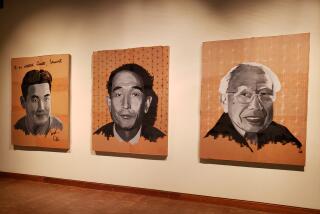Reflections of a Time of Rapid Change
- Share via
PORTLAND, Ore. — PORTLAND, Ore. -- Three bronze demons with pointed teeth, shaggy hair and wild eyes glare menacingly from beneath a massive urn decorated with stylized clouds and ribbons.
A bronze eagle perches atop the life-sized sculpture as the demons, like Atlas, struggle to hold the urn aloft with their rippling biceps.
The mighty incense burner is one of hundreds of vases, sculptures and textiles on display in “Splendors of Imperial Japan,” an exhibit on view at the Portland Art Museum through Sept. 22.
The 350-piece show, owned by Dr. Nasser D. Khalili of London, is dedicated to an artistic explosion that occurred in the late 1800s as Japan emerged from centuries of self-imposed isolation.
The exhibition explores art produced during the Meiji Period, a brief and intense span that bridged the gap between 250 years of isolationism and Japan’s role as a world power. It is Khalili’s first major Japanese exhibit on U.S. soil.
Between 1868 and 1912--just 44 years--Japanese artists threw themselves into their work, inventing techniques and materials to create what many experts consider the highest-quality art of its time.
“The Japanese decided that after 250 years of isolation they would embrace the rest of the world,” said Donald Jenkins, the Portland Art Museum’s curator of Asian art. “They did it in superb fashion. It was like a time warp.”
When the U.S. Navy appeared off Japan’s coast in 1854, the country realized its industrial and military weakness and rushed to make a name for itself the only way it knew how. “They were so concerned about being looked down upon, as being considered Third World,” said Jenkins. “One thing they could do before they had any industry was make art.”
In 1867, the ruling Emperor Komei died and the last shogun resigned. The new Meiji emperor, Mutsuhito, made sweeping reforms to modernize the country. He patronized the nation’s best artists, paying them handsomely to create high-quality artwork for export to Europe and America, and invested in elaborate pavilions at a string of world fairs.
The decision to emphasize art was also a practical one. Artisans whose only work had been to decorate swords and make ivory belt hooks suddenly had no customers. The new regime needed cash quickly and art, initially, was its only resource.
“They were hungry, and I think they were wise,” said Khalili. “Religion has its own language, politics has its own language, but the only language which is universal is the language of art.”
Within several years, Japan’s best artists were producing exquisite works in ivory, lacquer, enamel, bronze, porcelain and metal alloys unknown to the West. These pieces, the best of which make up the Khalili collection, were treasured in Europe and America for their exotic look and fine craftsmanship.
Eager to entice the West, the Meiji artists focused on themes that seem almost Victorian to attract foreign buyers. The art also emphasized Japanese traditions and locations that were known to the West, including famous tourist attractions and sculptures and paintings of daily life.
“They were in such a rush to catch up that everything was Western and there was a tendency to neglect their own culture,” Jenkins said. “In one sense, it’s like globalism had already occurred. Victorian taste and eclecticism had already shown up in Japan.”
Early Meiji pieces in the collection improve on the ornate, heavily decorated works that were favored in the West. Extravagant enameled and gilded vases from the 1880s by master Yabu Meizan depict pastoral scenes framed by countless tiny flowers in red, white and orange.
The rush to cater to the West didn’t last long, however.
By the turn of the century, there was a backlash against Western-looking pieces and artists reverted to sparser designs with negative space and traditional themes.
Because of its Western influence, Meiji art was shunned and forgotten in Japan for decades. Most Japanese were not familiar with the period because nearly all the pieces were exported.
More to Read
The biggest entertainment stories
Get our big stories about Hollywood, film, television, music, arts, culture and more right in your inbox as soon as they publish.
You may occasionally receive promotional content from the Los Angeles Times.










